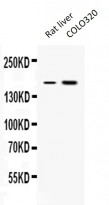ARG58586
anti-ERCC6 / CSB antibody
anti-ERCC6 / CSB antibody for Western blot and Human,Rat
Overview
| Product Description | Rabbit Polyclonal antibody recognizes ERCC6 / CSB |
|---|---|
| Tested Reactivity | Hu, Rat |
| Tested Application | WB |
| Host | Rabbit |
| Clonality | Polyclonal |
| Isotype | IgG |
| Target Name | ERCC6 / CSB |
| Antigen Species | Human |
| Immunogen | Synthetic peptide corresponding to aa. 160-205 of Human ERCC6 / CSB. (QAATSRDINRKLDSVKRQKYNKEQQLKKITAKQKHLQAILGGAEVK). |
| Conjugation | Un-conjugated |
| Alternate Names | RAD26; Cockayne syndrome protein CSB; ARMD5; COFS; EC 3.6.4.-; CKN2; CSB; UVSS1; COFS1; ATP-dependent helicase ERCC6; DNA excision repair protein ERCC-6 |
Application Instructions
| Application Suggestion |
|
||||
|---|---|---|---|---|---|
| Application Note | * The dilutions indicate recommended starting dilutions and the optimal dilutions or concentrations should be determined by the scientist. |
Properties
| Form | Liquid |
|---|---|
| Purification | Affinity purification with immunogen. |
| Buffer | 0.9% NaCl, 0.2% Na2HPO4, 0.05% Sodium azide and 5% BSA. |
| Preservative | 0.05% Sodium azide |
| Stabilizer | 5% BSA |
| Concentration | 0.5 mg/ml |
| Storage Instruction | For continuous use, store undiluted antibody at 2-8°C for up to a week. For long-term storage, aliquot and store at -20°C or below. Storage in frost free freezers is not recommended. Avoid repeated freeze/thaw cycles. Suggest spin the vial prior to opening. The antibody solution should be gently mixed before use. |
| Note | For laboratory research only, not for drug, diagnostic or other use. |
Bioinformation
| Database Links |
Swiss-port # Q03468 Human DNA excision repair protein ERCC-6 |
|---|---|
| Gene Symbol | ERCC6 |
| Gene Full Name | excision repair cross-complementation group 6 |
| Background | This gene encodes a DNA-binding protein that is important in transcription-coupled excision repair. The encoded protein has ATP-stimulated ATPase activity, interacts with several transcription and excision repair proteins, and may promote complex formation at DNA repair sites. Mutations in this gene are associated with Cockayne syndrome type B and cerebrooculofacioskeletal syndrome 1. Naturally-occurring readthrough transcription occurs between this gene and the adjacent PGBD3 gene (GeneID:267004), and results in a fusion protein that shares sequence with the product of each individual gene. The readthrough locus is represented by GeneID:101243544. [provided by RefSeq, Mar 2013] |
| Function | Essential factor involved in transcription-coupled nucleotide excision repair which allows RNA polymerase II-blocking lesions to be rapidly removed from the transcribed strand of active genes. Upon DNA-binding, it locally modifies DNA conformation by wrapping the DNA around itself, thereby modifying the interface between stalled RNA polymerase II and DNA. It is required for transcription-coupled repair complex formation. It recruits the CSA complex (DCX(ERCC8) complex), nucleotide excision repair proteins and EP300 to the at sites of RNA polymerase II-blocking lesions. [UniProt] |
| Cellular Localization | Nucleus. [UniProt] |
| Calculated MW | 168 kDa |
| PTM | Ubiquitinated at the C-terminus. Ubiquitination by the CSA complex leads to ERCC6 proteasomal degradation in a UV-dependent manner. Stabilized following interaction with KIAA1530/UVSSA, which promotes recruitment of deubiquitinating enzyme USP7, leading to deubiquitination of ERCC6 thereby preventing UV-induced degradation of ERCC6 by the proteasome. [UniProt] |
Images (1) Click the Picture to Zoom In






